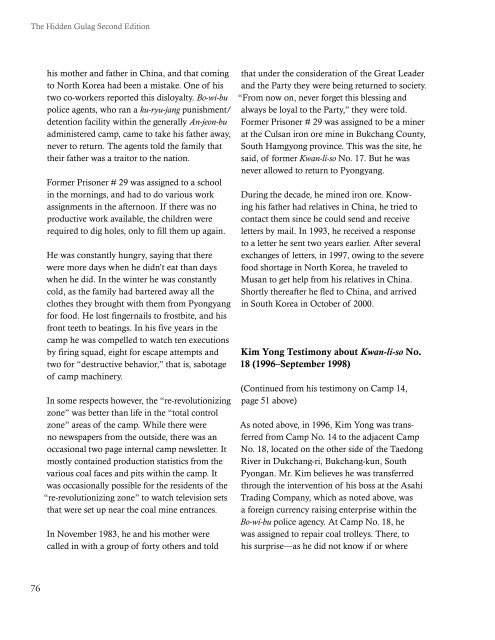The Hidden Gulag - US Committee for Human Rights in North Korea
The Hidden Gulag - US Committee for Human Rights in North Korea
The Hidden Gulag - US Committee for Human Rights in North Korea
Create successful ePaper yourself
Turn your PDF publications into a flip-book with our unique Google optimized e-Paper software.
<strong>The</strong> <strong>Hidden</strong> <strong>Gulag</strong> Second Editionhis mother and father <strong>in</strong> Ch<strong>in</strong>a, and that com<strong>in</strong>gto <strong>North</strong> <strong>Korea</strong> had been a mistake. One of histwo co-workers reported this disloyalty. Bo-wi-bupolice agents, who ran a ku-ryu-jang punishment/detention facility with<strong>in</strong> the generally An-jeon-buadm<strong>in</strong>istered camp, came to take his father away,never to return. <strong>The</strong> agents told the family thattheir father was a traitor to the nation.Former Prisoner # 29 was assigned to a school<strong>in</strong> the morn<strong>in</strong>gs, and had to do various workassignments <strong>in</strong> the afternoon. If there was noproductive work available, the children wererequired to dig holes, only to fill them up aga<strong>in</strong>.He was constantly hungry, say<strong>in</strong>g that therewere more days when he didn’t eat than dayswhen he did. In the w<strong>in</strong>ter he was constantlycold, as the family had bartered away all theclothes they brought with them from Pyongyang<strong>for</strong> food. He lost f<strong>in</strong>gernails to frostbite, and hisfront teeth to beat<strong>in</strong>gs. In his five years <strong>in</strong> thecamp he was compelled to watch ten executionsby fir<strong>in</strong>g squad, eight <strong>for</strong> escape attempts andtwo <strong>for</strong> “destructive behavior,” that is, sabotageof camp mach<strong>in</strong>ery.In some respects however, the “re-revolutioniz<strong>in</strong>gzone” was better than life <strong>in</strong> the “total controlzone” areas of the camp. While there wereno newspapers from the outside, there was anoccasional two page <strong>in</strong>ternal camp newsletter. Itmostly conta<strong>in</strong>ed production statistics from thevarious coal faces and pits with<strong>in</strong> the camp. Itwas occasionally possible <strong>for</strong> the residents of the“re-revolutioniz<strong>in</strong>g zone” to watch television setsthat were set up near the coal m<strong>in</strong>e entrances.In November 1983, he and his mother werecalled <strong>in</strong> with a group of <strong>for</strong>ty others and toldthat under the consideration of the Great Leaderand the Party they were be<strong>in</strong>g returned to society.“From now on, never <strong>for</strong>get this bless<strong>in</strong>g andalways be loyal to the Party,” they were told.Former Prisoner # 29 was assigned to be a m<strong>in</strong>erat the Culsan iron ore m<strong>in</strong>e <strong>in</strong> Bukchang County,South Hamgyong prov<strong>in</strong>ce. This was the site, hesaid, of <strong>for</strong>mer Kwan-li-so No. 17. But he wasnever allowed to return to Pyongyang.Dur<strong>in</strong>g the decade, he m<strong>in</strong>ed iron ore. Know<strong>in</strong>ghis father had relatives <strong>in</strong> Ch<strong>in</strong>a, he tried tocontact them s<strong>in</strong>ce he could send and receiveletters by mail. In 1993, he received a responseto a letter he sent two years earlier. After severalexchanges of letters, <strong>in</strong> 1997, ow<strong>in</strong>g to the severefood shortage <strong>in</strong> <strong>North</strong> <strong>Korea</strong>, he traveled toMusan to get help from his relatives <strong>in</strong> Ch<strong>in</strong>a.Shortly thereafter he fled to Ch<strong>in</strong>a, and arrived<strong>in</strong> South <strong>Korea</strong> <strong>in</strong> October of 2000.Kim Yong Testimony about Kwan-li-so No.18 (1996–September 1998)(Cont<strong>in</strong>ued from his testimony on Camp 14,page 51 above)As noted above, <strong>in</strong> 1996, Kim Yong was transferredfrom Camp No. 14 to the adjacent CampNo. 18, located on the other side of the TaedongRiver <strong>in</strong> Dukchang-ri, Bukchang-kun, SouthPyongan. Mr. Kim believes he was transferredthrough the <strong>in</strong>tervention of his boss at the AsahiTrad<strong>in</strong>g Company, which as noted above, wasa <strong>for</strong>eign currency rais<strong>in</strong>g enterprise with<strong>in</strong> theBo-wi-bu police agency. At Camp No. 18, hewas assigned to repair coal trolleys. <strong>The</strong>re, tohis surprise—as he did not know if or where76



